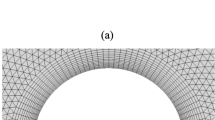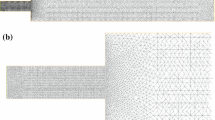Abstract
This work employed shape optimization to enhance the stability of the flow past a single-degree-of-fredom transversely vibrating cylinder at subcritical Reynolds numbers (Re < 47). Dynamic derivative is used as the optimization objective. To improve the calculation efficiency, a surrogate model is constructed to replace the numerical simulation in the optimization process. Research shows that through the shape optimization, vortex-induced vibration is successfully suppressed at design conditions and the stability of the fluid–structure interaction system is remarkably improved.
Access this chapter
Tax calculation will be finalised at checkout
Purchases are for personal use only
Similar content being viewed by others
References
Holland JH (1992) Adaptation in natural and artificial systems: an introductory analysis with applications to biology, control, and artificial intelligence. Ann Arbor 6(2):126–137
Peter JEV, Dwight RP (2010) Numerical sensitivity analysis for aerodynamic optimization: a survey of approaches. Comput Fluids 39(3):373–391
Storn R, Price K (1997) Differential evolution–a simple and efficient heuristic for global optimization over continuous spaces. J Global Optim 11(4):341–359
Williamson CHK, Govardhan R (2004) Vortex-induced vibrations. Annu Rev Fluid Mech 36(1):413–455
Cossu C, Morino L (2000) On the instability of a spring-mounted circular cylinder in a viscous flow at low Reynolds Numbers. J Fluids Struct 14(2):183–196
Mittal S, Singh S (2005) Vortex-induced vibrations at subcritical Re. J Fluid Mech 534(534):185–194
Li X, Zhang W, Jiang Y, Ye Z (2015) Stability analysis of flow past anelastically-suspended circular cylinder. Chin J Theor Appl Mech 47(5):874
Da Ronch A, Vallespin D, Ghoreyshi M et al (2012) Evaluation of dynamic derivatives using computational fluid dynamics. AIAA J 50(2):470–484
Liu X, Liu W, Zhao Y (2015) Unsteady vibration aerodynamic modeling and evaluation of dynamic derivatives using computational fluid dynamics. Math Prob Eng
Zhang W, Yiming G, Yilang LIU (2018) Abnormal changes of dynamic derivatives at low reduced frequencies. Chin J Aeronaut 31(7):1428–1436
Chen WL, Xin DB, Xu F et al (2013) Suppression of vortex-induced vibration of a circular cylinder using suction-based flow control. J Fluids Struct 42(4):25–39
Du L, Sun X (2015) Suppression of vortex-induced vibration using the rotary oscillation of a cylinder. Phys Fluids 27(2):195–2023
Huera-Huarte FJ (2017) Suppression of vortex-induced vibration in low mass-damping circular cylinders using wire meshes. Marine Struct 55:200–213
Jiang Y (2013) Numerical solution of Navier–Stokes equations on generalized mesh and its applications. NWPU, Xi’an, China (Ph. D. thesis)
Boer AD, Schoot MSVD, Bijl H (2007) Mesh deformation based on radial basis function interpolation. Comput Struct 85(11):784–795
Kulfan B, Bussoletti J (2006) “Fundamental” parameteric geometry representations for aircraft component shapes. In: Aiaa Paper, pp 1–45
Park J, Sandberg IW (1991) Universal approximation using radial-basis-function networks. Neural Comput 3(2):246–257
Author information
Authors and Affiliations
Corresponding author
Editor information
Editors and Affiliations
Rights and permissions
Copyright information
© 2021 The Author(s), under exclusive license to Springer Nature Singapore Pte Ltd.
About this paper
Cite this paper
Chen, W.G., Zhang, W.W., Li, X.T. (2021). Shape Optimization Considering the Stability of Fluid–Structure Interaction at Low Reynolds Numbers. In: Braza, M., Hoarau, Y., Zhou, Y., Lucey, A.D., Huang, L., Stavroulakis, G.E. (eds) Fluid-Structure-Sound Interactions and Control. FSSIC 2019. Lecture Notes in Mechanical Engineering. Springer, Singapore. https://doi.org/10.1007/978-981-33-4960-5_17
Download citation
DOI: https://doi.org/10.1007/978-981-33-4960-5_17
Published:
Publisher Name: Springer, Singapore
Print ISBN: 978-981-33-4959-9
Online ISBN: 978-981-33-4960-5
eBook Packages: EngineeringEngineering (R0)




